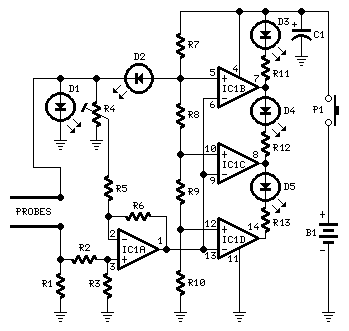Detects the amount of salt contained in liquid foods
Three-level LED indicator
Circuit diagram

Parts:
R1 470R 1/4W Resistor
R2,R5 10K 1/4W Resistors
R3,R6 220K 1/4W Resistors
R4 5K 1/2W Trimmer Cermet
R7 680R 1/4W Resistor
R8 2K2 1/4W Resistor
R9,R10,R11,R12,R13 1K 1/4W Resistors
C1 100µF 25V Electrolytic Capacitor
D1,D2,D3 3 or 5mm. Red LEDs
D4 3 or 5mm. Green LED
D5 3 or 5mm. Yellow LED
IC1 LM324 Low Power Quad Op-amp
P1 SPST Pushbutton
Probes (See Text)
B1 9V PP3 Battery
Clip for PP3 Battery
Device purpose:
This circuit was designed to detect the approximate percentage of salt contained in a liquid. After careful setting it can be useful to persons needing a quick, rough indication of the salt content in liquid foods for diet purposes etc.
Circuit operation:
IC1A op-amp is wired as a DC differential amplifier and its output voltage increases as the DC resistance measured at the probes decreases. In fact, fresh water has a relatively high DC resistance value that will decrease proportionally as an increasing amount of salt is added.
IC1B, IC1C and IC1D are wired as comparators and drive D5, D4 and D3 in turn, as the voltage at their inverting inputs increase. Therefore, no LED will be on when the salt content of the liquid under test is very low, yellow LED D5 will illuminate when the salt content is low, green LED D4 will illuminate if the salt content is normal and red LED D3 will illuminate if the salt content is high.
D1 and D2 are always on, as their purpose is to provide two reference voltages, thus improving circuit precision. At D2 anode a stable 3.2V supply feeds the non-inverting inputs of the comparators by means of the reference resistor chain R8, R9 and R10. The 1.6V reference voltage available at D1 anode feeds the probes and the set-up trimmer R4.
One of these two red LEDs may be used as a pilot light to show when the device is on.
Probes:
It was found by experiment that a good and cheap probe can be made using a 6.3mm. mono jack plug. The two plug leads are connected to the circuit input by means of a two-wire cable (a piece of screened cable works fine).
The metal body of the jack is formed by two parts of different length, separated by a black plastic ring. You should try to cover the longest part with insulating tape in order to obtain an exposed metal surface of the same length of the tip part, i.e. about 8 to 10mm. starting from the black plastic ring.
In the prototype, three tablespoons of liquid were poured into a cylindrical plastic cap of 55mm. height and 27mm. diameter, then the metal part of the jack probe was immersed in the liquid.
Notes:
Wait at least 30 seconds to obtain a reliable reading.
Wash and wipe carefully the probe after each test.
To setup the circuit and to obtain a more precise reading, you may use a DC voltmeter in the 10V range connected across pin #1 of IC1A and negative supply.
Set R4 to obtain a zero reading on the voltmeter when the probe is immersed in fresh water.
You may change at will the threshold voltage levels at which the LEDs illuminate by trimming R4. Vary R8 value to change D4 range and R9 value to change D5 range.
P1 pushbutton may be substituted by a common SPST switch.
author: RED Free Circuit Designs
e-mail:
web site:
http://www.redcircuits.com/
 Audio (49)
Audio (49) Power & high voltage (43)
Power & high voltage (43) Radio (23)
Radio (23) Light & LED (31)
Light & LED (31) Tools & measurement (40)
Tools & measurement (40) Telephone (18)
Telephone (18) Automotive (10)
Automotive (10) Microcontrollers (12)
Microcontrollers (12) Sensors & control (47)
Sensors & control (47) Timers & oscillators (40)
Timers & oscillators (40) Miscellaneous (26)
Miscellaneous (26)
